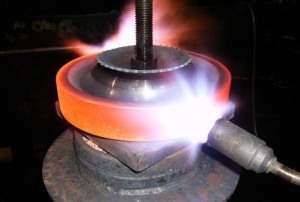Metlab recently undertook a project with a major crane manufacturer to flame harden the bridge crane wheels for a large overhead multiple bridge crane system. The crane is installed at an aircraft manufacturer and is used to lift airplanes as they are being assembled. Over 1,500 wheels approximately 6 1/2″ O.D. x 2 1/2″ wide, made from 1045 steel were hardened. The requirement was a hard and uniform outside rim hardened to 425 BHN (HRC 45) and a case depth of 1/8″, minimum.
Flame hardening is a surface hardening treatment where the outside of the component is uniformly heated by direct application of a flame. Special burners combining a fuel gas (typically acetylene or) and oxygen are used to generate the flame. Temperature is monitored optically comparing the color of the heated steel to a color/temperature chart as well as using infra-red temperature sensors. When the surface of the part has been hardened to a sufficient depth, the surface is then rapidly cooled by either oil or water quenching, depending on the material being hardened.
The component is then tempered to the appropriate hardness and microstructure. The advantage of flame hardening for a part like a crane wheel is that the process hardens the outside surface only providing a deep case. This results in a highly wear resistant surface, as well as increased bending fatigue strength, while leaving a tough core which can absorb shock, and loading. And as opposed to through hardening, since only a small portion of the wheel is hardened (the surface) there is little or no distortion.
Gears, wheels, rolls and other cylindrical parts are spin flame hardened. They are placed on a motorized table, as shown in the figure, and spun while a flame impinges on the outer diameter of the wheel. For flame hardening to be effective, the component being hardened must have a carbon content of greater than 0.3 % carbon. This includes steel as well as cast iron components. Metlab has the ability to flame harden parts up to 14″ in diameter. Metlab can also flame harden rectangular pieces, like gear racks, machineways, rails, and wear plates.
Metlab has also flame and induction hardened the treads of crane sheaves, crane gears, and also rollers. In addition to these components, Metlab has carburized and hardened other crane components, most significantly hoist drums. These drums are the large cylinders that are used to take up crane wires. While some hoist drums are made from an alloy steel like and are flame hardened, it is not uncommon for the hoist drum to be made from low carbon steel like A-36 to save the cost of material and fabrication and then carburize and harden the drum. Carburizing provides abrasive wear protection to the grooves in the hoist drum, where the hardened steel wires are wound onto the drum.

1045 Steel Bridge Crane Wheel being flame hardened. Wheel is placed on a motorized turntable and burners apply flames to uniformly heat the rim of the wheel to the appropriate hardening temperature. When the rim has been soaked through, it is rapidly quenched, and then the parts tempered resulting in the high hardness required for the application.



